Grape Varietal
Nova Scotia
Work in Progress
White Hybrids
 |
L'Acadie Blanc
-
The signature white grape of Nova Scotia. Created in Vineland, Ontario, this grape proved unsuitable to the Ontario climate but produces excellent wines in Nova Scotia.
The grape was created in 1953 by grape breeder Ollie A. Bradt in Niagara, Ontario at the Vineland Horticultural Research Station which is now the Vineland Research and Innovation Centre. Today the grape is widely planted in Nova Scotia with some plantings in Quebec and Ontario.
-
The grape is hardy, early-ripening and disease resistant.
-
Fresh and refined, L'Acadie Blanc typically produces dry, medium bodied white wines with fresh flavours such as citrus fruit, and a slight herbaceous character. Oak-aged versions often develop buttery nuances, pear and apple flavours, and creamy textures the perfect match to Digby Scallops or Atlantic Smoked Salmon.
-
L'Acadie Winemaker Bruce Ewert has always said that the climate is perfect in the Gaspereau Valley for making
traditional method (TM) sparkling wine and that L'Acadie is an appropriate grape
Some top producers are Domaine de Grand Pré, Jost Vineyards, Sainte Famille and
Annapolis Highland Vineyards. L'Acadie vineyards uses it to make their award winning Sparkling wines.
|
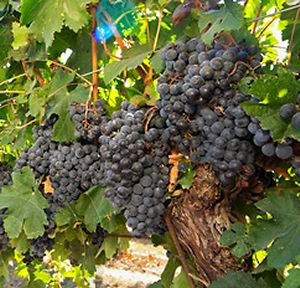 |
Castel
is a French American hybrid (specifically a V. riparia X Gamay cross), which was bred to take severe winters, ripen early with high Brix (fermentable sugar) and produce big crops. Produces red wine.
It has limited use in BC but is more prominent in Nova Scotia. Domain de Grand Pre was won Gold for their Castel
Jost is another producer using grapes from
Warner Vineyards.
|
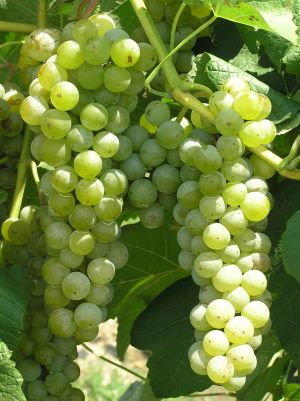 |
Cayuga
a wine grape was developed from crosses of the hybrids Schuyler and Seyval Blanc done at Cornell University 's New York State Agricultural Experiment Station in Geneva, New York . It is a hardy vine with some bunch-rot disease resistance. It should be picked at low sugars to avoid over-ripe, sometimes labrusca -like, flavours. Picked at the proper time it can produce a very nice sparkling wine with good acid balance, structure, and pleasant aromas or a fruity white wine similar to a Riesling .
Vineyard Cote de Bras d'Or owner John Pratt was the first to grow grape vines in Cape Breton. He has 5.6 hectares overlooking the Bras d'Or Lake
2011 Cote de Bras d'Or Cayuga from Jost is a medal winner
|
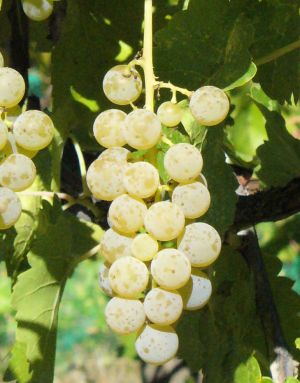 |
Geisenheim GM318-57:
White wine producing hybrid cultivar technically known as GM318-57 created in 1957. Reported as derived from Riesling cl.239 F2 and Chancellor parents . Moderately winter hardy. Susceptible to leaf burn from copper-containing sprays and fungus diseases such as Powdery Mildew. Usually ripens late September where successfully grown in Nova Scotia, Canada. A reportedly slightly hardier yet similar hybrid is the Jost (Geisenheim). A somewhat similar cultivar, currently grown on the south island of New Zealand, is a variety named Breidecker. It can be found in Quebec
Top producers are Jost Vineyards
|
 |
Marechal Joffre
The grape comes from the same cross as Marechal Foch and Leon Millot. The Mgt 101-14 x Goldriesling cross was made by Eugene Kuhlmann in France in the early 1900's. This variety is said to be earlier ripening than Leon Millot
This variety is very disease resistant, similar to that of Foch, and cold hardy to about the same as Leon Millot -27c. The clusters and berries are small but there are usually 2-3 clusters per shoot. The juice of the Joffre berries resembles that of the other Kulhmann hybrids with a little less pronounced berry fruit expression. However, on the chemistry side the juice can reach a high Brix in the 23-25 Brix range while the acid levels are better than Foch which can often be quite high
Can also be found in New Brunswick
Grown by Jost Vineyards Vineyards
|
 |
New York Muscat
This large, blue skinned grape was bred in Geneva, New York. It is intensely flavoured and extremely popular in Nova Scotia. The grapes are used in dry wines and Icewines. Bold and exotic, New York Muscat produces aromatic but dry full-bodied white wines with intense aromas of roses, grapefruit and exotic fruit such as lychee. has a labruscia like growth habit good hardiness and disease resistant mow yields but produces a nice wine.
Some top producers are Domaine de Grand Pré and Jost Vineyards
|
 |
Ortega
Across between Muller-Thurgau and Siegerrebe varieties mostly used for white wine blending. Cold-hardy grape found in Germany and Canada. Comparable to Riesling.
Ortega ripens early, is not sensitive to frost and reaches quite high must weights , typically 20 degrees Oechsle higher than Müller-Thurgau. It is therefore often used for sweet wines, which are considered to improve with cellaring. Ortega wines have aromas of Muscat and peach and are high in extract
Ortega's winter-hardy character has allowed this grape to be successfully grown in British Columbia, and with limited success in Canada's eastern province of Nova Scotia
Some top producers are Domaine de Grand Pré, Luckett and Jost
|
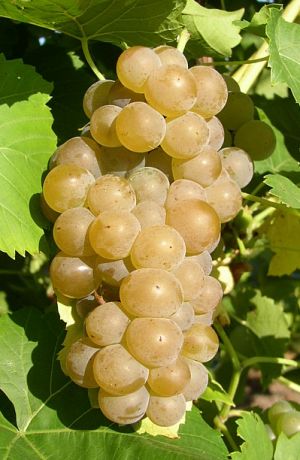 |
Seyval Blanc
This grape is hardy and versatile and performs well in Nova Scotia's warmer regions. Crisp and clean, Seyval Blanc produces light to medium-bodied white wines with crisp citrus fruit aromas and flavours has a sweet and clean bouquet reminiscent of pears and citrus fruit
a great - aperitif or to enjoy with simply prepared mussels or light white fish such as sole.
know as Seyve-Villard 5-276 hybrid
Seyval Blanc was created either by Bertille Seyve , or his son-in-law Villard, as a cross of Seibel 5656 and Rayon d'Or (Seibel 4986
some top producers are Jost Vineyards,Domaine de Grand Pré,
Petite's Rivieres. Blomidon Estates and Sainte Famillie
|
 |
Vidal Blanc
Lively and versatile, Vidal Blanc's fresh lemony flavours and vibrant acidity make it well suited to making dry, off-dry or impeccably balanced Icewines. a late ripping varietal with moderate winter hardiness Primary use is icewine
Domaine de Grand Pré and Jost area top producer.
Avondale Sky Winery produces a dessert wine called
Pinnacle Hill with Vidal.
|
White Vinifera
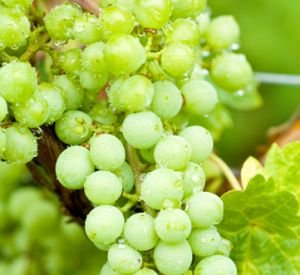
|
Chardonnay
- Newer to Nova Scotia because of winter hardiness concerns, Chardonnay is performing quite well and ripening into nice quality grapes.
- A classic vinifera, elegant and refined, Nova Scotia Chardonnay is crisp and clean with green apple and mineral notes on the nose and palate. Oak aged versions develop toasty notes on the nose and rich, creamy textures a must with grilled Nova Scotia seafood such as salmon.
- It can only be grown in the mild winter minimal regions Annapolis Valley and South Shore
- for more Chardonnay
Top producers are Blomidon
|
 |
Muscat v species Vitis vinifera is widely grown for wine , raisins and table grapes . Their color ranges from white to near black. Muscat almost always has a pronounced sweet floral aroma . Muscat grapes are grown around the world. The breadth and number of varieties of muscat suggest that it is perhaps the oldest domesticated grape variety, and there are theories that most families within the Vitis vinifera grape variety are descended from the Muscat variety
Muscat Blanc: is the most popular varietal. Is marked by a pale yellow colour and floral notes. Muscat Blanc is pictured.
Muscat Ottonel is often used in dessert wines.
Black Muscat and Orange Muscat: more high-end, dessert wine Orange Muscat is more common in California.
top producers Gaspereau Vineyards,
Lunenburg County Winery,
Sainte Famille Wines Ltd
and Luckett Vineyards
|
 |
Riesling
is a white grape variety which originated in the Rhine region of Germany . Riesling is an aromatic grape variety displaying flowery, almost perfumed, aromas as well as high acidity. It is used to make dry, semi-sweet, sweet and sparkling white wines . Riesling wines are usually varietally pure and are seldom oaked . It is usually included in the "top three" white wine varieties together with Chardonnay and Sauvignon Blanc . Riesling is a variety which is highly " terroir -expressive", meaning that the character of Riesling wines is clearly influenced by the wine's place of origin.
Ontario has always been know for its Riesling and its use in Icewine. In BC the grape is also popular and used in icewine. Because it has good winter hardiness and is used in Sparkling wines its popularity is increasing in Nova Scotia
top producers Gaspereau Vineyards and Jost.
Geisenheim Riesling is produced by Annapolis Heights Vineyards
|
 |
Cayuga White
is a wine grape was developed from crosses of the hybrids Schuyler and Seyval Blanc done at Cornell University 's New York State Agricultural Experiment Station in Geneva, New York . It is a hardy vine with some bunch-rot disease resistance. It should be picked at low sugars to avoid over-ripe, sometimes labrusca -like, flavours. Picked at the proper time it can produce a very nice sparkling wine with good acid balance, structure, and pleasant aromas or a fruity white wine similar to a Riesling.
Petite Riviere's Lulu Rosé is made from Leon Millot and Cayuga White
|
Red Hybrids
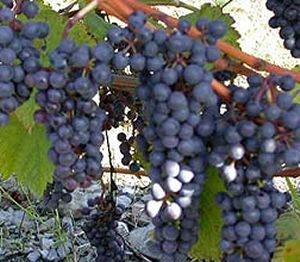 |
Baco Noir
Rich and smoky, Baco Noir produces full-bodied dry red wines with earthy, smoky and game-like aromas and flavours a must with local game such as venison.
For More information on Baco see Baco
Jost is a top producer
|
 |
De Chaunac
is a French-American hybrid wine grape variety used to make red wines . It was developed by Albert Seibel circa 1860. It is also known as Seibel 9549 and is a cross of Seibel 5163 and possibly Seibel 793. The grape was named after Adhemar de Chaunac , a pioneer in the Ontario wine industry.
De Chaunac is known to have a very vigorous growth habit and good resistance to powdery mildew and downy mildew . It is grown in varying amounts for wine production across the northeastern side of North America, especially in the wine growing regions of New York , Pennsylvania, Nova Scotia, Ontario, New Brunswick, Michigan , and other northeastern wine growing areas.
|
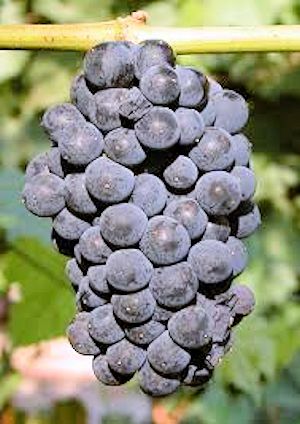 |
Leon Millot
is a red variety of hybrid grape; it was created in 1911 in the Oberlin Institute in Colmar, Alsace , by the French viticulturist Eugène Kuhlmann (18581932) by crossing the hybrid grape Millardet et Grasset 101-14 O.P. (which is Vitis riparia × Vitis rupestris ) with Goldriesling , which is Vitis vinifera . The variety was named after the winemaker and tree nursery owner Léon Millot.
Léon Millot ripens early, hardy, vigorous and disease resistant. It has high resistance against fungal diseases. It is therefore suited for cultivation in colder climates. It gives powerful wine with some foxy aromas
Vibrant and fruity, Leon Millot produces dry medium-bodied wines dominated by black cherry, berry fruit and peppery characteristics ideal with most meats and dishes with tomato based sauces.
|
 |
Lucie Kuhlmann
A sister variety of Leon Millot that produces a slightly bigger crop and is earlier ripening. The wines are bold in colour but with lower tannins. Big and fruity, Luci Kuhlmann produces full flavoured dry red wines with berry fruit and smoky notes on the nose. On the palate, they are rich and often have slightly spicy finishes a Nova Scotia red to enjoy with grilled beef or hearty stews.
top producers Van Cliche and Luckett
|
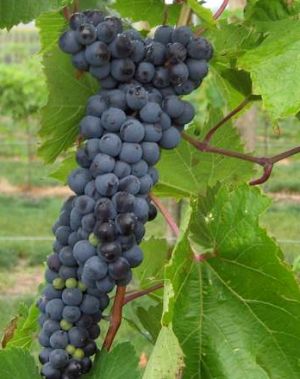 |
Marechal Foch
This grape is reliable, hardy and common in Nova Scotia vineyards. Refined and characterful, Marechal Foch produces medium to full-bodied red wines with distinctive berry and bell pepper aromas and flavours. Oak-aged versions offer a great balance of fruit character with dry, slightly tannic finishes enjoy with Nova Scotia lamb.
Jost Vineyards is a good producer
For more information on Marechal Foch see
Grape Varietal BC
|
 |
Marquette
is an inter-specific hybrid red wine grape variety. It was developed at the University of Minnesota , and is a cross between two other hybrids, MN 1094 and Ravat 262 Marquette's high sugar and moderate acidity make it very manageable in the winery. Finished wines are complex, with attractive ruby color, pronounced tannins, and desirable notes of cherry, berry, black pepper, and spice on both nose and palate.
Bruce Ewert, L'Acadie Vineyards is growing Marquette for his Sparkling wines. Jost vineyards grows Marquette
Marquette can also be found in Ontario
|
Red Vinifera
 |
Pinot Noir
( French: [pino nwa?] ) is a black wine grape variety of the species Vitis vinifera . The name may also refer to wines created predominantly from Pinot noir grapes. The name is derived from the French words for "pine" and "black" alluding to the grape variety's tightly clustered dark purple pine-cone shaped bunches of fruit.
Pinot noir grapes are grown around the world, mostly in the cooler regions, but the grape is chiefly associated with the Burgundy region of France . It is widely considered to produce some of the finest wines in the world, but is a difficult variety to cultivate and transform into wine
Though still in the experimental stages, the grapes are able to ripen and over-winter. Two wine vintages have been produced locally.
-
Light and earthy, Nova Scotia Pinot Noir is light and elegant with subtle berry and earthy aromas. On the palate it is light with dry, crisp finishes a Nova Scotia red wine to match with salmon
Bear River is a producer
Benjamin Bridge uses Pinot Noir (57%), Chardonnay, L'Acadia and Vidal to make their Brut Reserve
|
 |
Triomphe d'Alsace
is a black grape variety of Franco-German origin, commonly grown in the United Kingdom. Also found in Nova Scotia.
Triomphe d'Alsace was produced by Eugène Kuhlmann from about 1911 at the Institut Viticole Oberlin at Colmar in Alsace , then a part of Germany. First he crossed the American River Bank Grape, Vitis riparia with another American species, the Bush Grape, Vitis rupestris . The resultant hybrid was then crossed with Goldriesling , a variety of the wine grape, Vitis vinifera , developed about twenty earlier by Christian Oberlin. From a similar set of crosses came range of sibling varieties like Lucie Kuhlmann , Léon Millot , Marechal Foch , Maréchal Joffre , Pinard , Etoile I and Etoile II .
Gaspereau Vineyards and Luckett Vineyards are good producer
|
Nova Scotia is famous for its fruit. Their fruit wines, like some of the Nova Scotia grape wines, are sassy and bold. Examples of Nova Scotia fruit wines include Apple, Arctic Kiwi, Blueberry, Cranberry, Elderberry, Pear and Raspberry. They display a balance of light acidity and fresh fruit flavours. Served as aperitifs or creatively paired with food,
Jost Vineyards Maple Wine is made from maple syrup collected from trees in the vast maple forests of Nova Scotia. The maple "juice" was carefully cool fermented until the desired concentration of residual sugars was reached. The result is this unique full bodied dessert style wine which is sweet and flavourful yet soft and harmonious. This delicious wine captures the exquisite flavour and character of the maple tree. Sainte Famille also produces Maple wine.
(1)
It was created in Canada in 1953 by O. Bradt
Grape Varietal: British Columbia ~ Ontario ~ Quebec ~ New Brunswick ~ New Foundland
Special Thanks goes to
~ Robert Murray
~ John Lewis of Perennia
~ Dr. Andrew R. Jamieson Fruit Breeding | Amélioration génétique des fruits | Agriculture and Agri-Food Canada
~ Bruce Ewert L'Acadie Vineyards
~ Jürg Stutz
~ Joanne Moran - GGANS
~ The Nova Scotia Wineries

Place your banner here
your support would be appreciated Advertising
Wineries of Canada
Home |Advertise| Gallery | Contact
Us | ©2023 Robert Bell
|






















